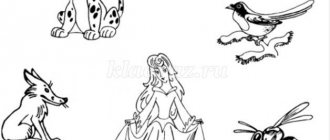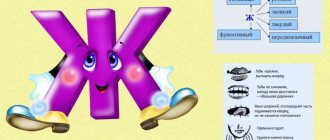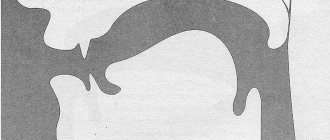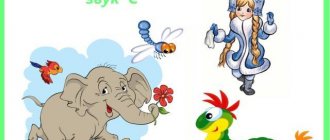Open group speech therapy session on production, automation and differentiation of sound [R]
First part of the lesson. Zero grade students. Speech conclusion: dyslalia, rhotacism. The lesson time is 20-25 minutes.
Topic: Sound production [P].
Goal: Staging, automation and differentiation of sound [P].
Tasks:
- Repeat articulation exercises for sound production;
- Repeat the articulation of the sound [P];
- Develop phonemic awareness;
- Practice preparatory exercises.
Equipment: Checked notebook, pencil, images of fairy-tale characters.
During the classes.
- Organizing time.
Guys, let's smile at each other and wish you a great day
- Message of the topic and purpose of the lesson:
Listen carefully to the poem that I will read. Early in the morning, a gloomy crayfish somehow digs a hole. Cancer would be glad not to dig it, But you have to live somewhere. Cancer does not want to work; he is not happy with his work. Tell me please, what sound did I pronounce more often? (Sound [R].)
That's right, we will practice correctly pronouncing the sound [R].
Today we will go to the Fairytale Forest. What do you think we will use to get there? (By car) What do we need to go on a trip by car? (Steering wheel, key, gas pedal and our tongue)
Well done. But before we set off, let's stretch our tongue and fingers a little so that they don't get tired during the journey.
- Repetition of the correct articulation of sound The lips smile, the teeth are open, the tip of the tongue is raised to the tubercles (alveoli), a strong air stream causes the tip of the tongue to vibrate, the voice works.
- Articulation gymnastics:
Exercise “brushing your teeth” Purpose. Develop upward tongue movement and language proficiency. Description. Open your mouth wide and use the tip of your tongue to “brush” the inside of your upper teeth, moving your tongue from side to side.
- Lips in a smile, upper and lower teeth visible.
- Make sure that the tip of the tongue does not protrude or bend inward, but is located at the roots of the upper teeth.
- The lower jaw is motionless; Only the language works.
Painter . Target. Practice the upward movement of the tongue and its mobility. Description. Smile, open your mouth and “stroke” the roof of your mouth with the tip of your tongue, moving your tongue back and forth.
- The lips and lower jaw should be motionless.
- Make sure that the tip of the tongue reaches the inner surface of the upper teeth as it moves forward and does not protrude from the mouth.
Delicious jam . Target. Develop an upward movement of the wide front part of the tongue and a position of the tongue close to the shape of a cup, which it takes when pronouncing hissing sounds. Description. Open your mouth slightly and lick your upper lip with the wide front edge of your tongue, moving your tongue from top to bottom, but not from side to side.
- Make sure that only the tongue works, and the lower jaw does not help; it must be motionless (you can hold it with your finger).
- The tongue should be wide, its side edges touching the corners of the mouth.
Turkey . Target. Develop the upward movement of the tongue and the mobility of its front part. Description. Open your mouth slightly, put your tongue on your upper lip and move the wide front edge of your tongue along your upper lip back and forth, trying not to lift your tongue from your lip - as if stroking it. First, make slow movements, then speed up the pace and add your voice until you hear bl-bl (like a turkey babbling).
- Make sure that the tongue is wide and does not narrow.
- So that the tongue moves forward and back, and not from side to side.
- The tongue should “lick” the upper lip, and not be thrown forward.
Drummers . Target. Strengthen the muscles of the tip of the tongue, develop the upward movement of the tongue and the ability to make the tip of the tongue tense. Description. Smile, open your mouth and tap the tip of your tongue on the upper alveoli, repeatedly and clearly pronouncing the sound D. First, the sound should be pronounced slowly, gradually increasing the tempo.
- The mouth should be open all the time, lips in a smile, lower jaw motionless; Only the language works.
- Make sure that the sound D has the character of a clear blow - not squelching.
- The tip of the tongue should not curl up.
- The sound must be pronounced so that the exhaled air stream is felt.
Well done. All the charging has been done correctly, now let's hit the road. And so we prepared the steering wheel, inserted the key and started the car. (The technique of making a sound from the sound D is used. The mouth is wide open, the front edge of the tongue is raised by the upper teeth to the alveoli. The child speaks with an aspiration D-D-D and smoothly moves to the sound R- R-R. The tongue “jumps on the tubercles.” The blows of the tip of the tongue, which either touches the alveoli or bounces off, are clearly visible.)
We started the car great, now we press the gas pedal (children pronounce the sound D briefly and switch to R-DR)
Guys, since we are going to a fairytale forest, who do you think we might meet along the way? Fairy-tale characters: Malvina, Cinderella, Shrek, SpongeBob and Patrick, Smeshariki.
So we arrived at the Fairytale Forest. You are probably tired after the road, let's rest a little and do some exercises
- Physical exercise.
The wind blows in our faces
The tree swayed
The breeze is getting quieter and quieter
The tree is getting higher and higher
What time of year is it outside? (Spring) Have leaves already appeared on the trees or not yet? (No) And in the fairy-tale forest, leaves already appeared on the trees.
- Exercises to practice proper breathing
Let's blow on the leaves carefully so that none of them come off and fall, as if a light breeze were blowing. Now let’s blow very, very strong, like a strong wind blows.
- Exercises to develop phonemic hearing.
- Look who we met in the fairytale forest. These are fairy-tale heroes. Name them.
(Object pictures of fairy-tale characters are displayed. Children name them.)
Little Red Riding Hood, Chipolino, Snow Queen, Pinocchio, Cheburashka, Kolobok, Pierrot, Cinderella.
—Which hero do you like best and why?
- Choose among fairy-tale heroes those whose names sound [P].
— What can you tell us about the sound [R]? (Consonant, voiced, hard)
8. Practicing sounds in syllables
Fairy-tale heroes left us a task. You need to read syllables with the sound R. Replacing it with DR.
RA-RO-RU IR-AR-OR RTA-RTO-RTU
AR-OR-UO RAR-ROR-RUR TRA-TRO-TRO
The journey to the fairy forest is coming to an end. It's time for us to return home. But in order for us to go back, we need to complete the task of the Snow Queen. (Children open their notebooks and take pencils)
9. Graphic dictation
The child draws lines in a notebook in a square, under the dictation of a speech therapist: 3 cells left, 2 up, 3 right, 2 up, 6 right, 2 down, 3 right, 2 down, 3 left. What happens? Car. Let's finish the wheels. Now you can go. We get into our car again, but in order to drive we need to do a finger exercise. To do this, we wipe our hands, hide our finger under the tongue, pronounce the letter D-D-D and move our finger from side to side.
10. Summing up
So you and I have returned from the Fairytale Forest.
-Let's remember who we met there? (Little Red Riding Hood, Chipolino, Snow Queen, Pinocchio, Cheburashka, Kolobok, Pierrot, Cinderella.)
-What letter did we work on the pronunciation of today?
-You all did a great job today, and for such excellent work I want to reward you with medals.
Buzykaeva Inna Olegovna Teacher-speech therapist, KSU “Kondratovskaya secondary school” CKO, Kyzylzhar district, Kondratovka village
Audio Automation Recommendations
As soon as the child manages to pronounce R, begin his automation in syllables. Before doing this, practice making a long, rolling sound, let your tongue get used to the feeling of vibration. Usually, correct pronunciation is reinforced in straight syllables (RA, RO, RU), but in the case of the sound P, some children find it easier when it is in a solid position, and not when the organs of articulation occupy the position of the subsequent vowel.
At the stage of consolidation in syllables, use syllabic paths and pure phrases. Proceed with consolidation in words only when the child confidently pronounces R in syllables. Offer the following tasks: come up with words for this sound, name all the objects, for example, in the room, that have this sound. To practice correct pronunciation in phrases, short poems are suitable; you can compose phrases from the proposed words, tongue twisters.
Then comes automation in sentences and coherent speech. The child can compose stories based on the picture, from the proposed list of words. An adult can come up with a fairy tale about the sound R and invite the child to retell it. At the same time, you need to work on correlating the sound with the letter: write the letter P, lay it out from available materials.
At the beginning of the automation stage in tasks, speech material should be saturated with the sound R. The organs of articulation must remember the correct position during pronunciation, and the child fixes its correct sound in speech. Also, in speech therapy exercises for the sound R, at the very beginning of reinforcement, the adult pronounces it together with the child, then the child repeats it. And then the speech therapist or parents ask him to say it himself. When selecting speech material, do not use words using the soft version of R and the sounds L and L`. Speech material must correspond to children's perception.
Staging methods
Correction needs to be done in stages. After the preparatory work comes the staging stage.
There are several ways you can practice at home:
- From the “Mushroom” exercise. When the tongue is in the desired position, the child exhales forcefully onto the tip of the tongue. The result is vibration. For this method, the child must be able to exhale forcefully.
- Mechanical or "Chatterbox". For this method, you can use a ball probe, but at home, parents can use a cotton swab. The child performs the “Drummer” exercise, while the adult places the tip of a cotton swab under the tongue and makes oscillatory movements from side to side. You will get a combination of DR. But be sure to make sure that the D sound in the exercise is clear. For convenience, the child can be in a lying position.
- From a combination of healthy lifestyles. The wide tongue is raised by the upper teeth and the child pronounces the ZZ for a long time. He feels a slight vibration and with a stronger exhalation he will get R.
These are the most popular ways to create a sonorous sound yourself at home. In children with normal speech development, this sound appears through onomatopoeia. Provided that his articulatory apparatus is prepared. By the age of five years, a child should clearly pronounce all groups of sounds.
Reasons for violations
Why does a child have a problem with the pronunciation of R? There are several reasons, and to eliminate some of them you need the help of several specialists, not just a speech therapist:
- Anatomical features. These include a shortened hyoid frenulum, cleft lip, palate, and malocclusion.
- The air stream is not strong enough.
- Incorrect position of the organs of articulation - there are no anatomical disorders, but, for example, the tongue is in the wrong position because the child did not remember the correct articulation.
- Incorrect speech environment - often parents worry that if they burr, then their children will pronounce R incorrectly. This is not a genetic predisposition, but an incorrect speech environment. The child hears the incorrect pronunciation and tries to copy it. This is why rotacism arises.
- The child does not distinguish sounds by ear - this is a violation of the phonetic processes.
In addition, if there is a complex speech disorder - alalia, then incorrect sound pronunciation may be a consequence of insufficient activity of the speech areas of the brain. It is important to determine the exact cause of rhotacism and pararotacism in order to draw up a plan for corrective work.
Preparatory stage
Р and Р` are complex sounds, so before you start playing them, you need to do some preparatory work. This stage is based on articulatory gymnastics and includes exercises for the tongue. Exercises should be static (holding a certain position) and dynamic:
- "Smile". The lips are stretched in a smile, the teeth are together, the tongue is at the bottom.
- "Window". The mouth is open, the lips are in the same position as when pronouncing O, tongue down.
- "Fence". The lips are shaped like a square (as when pronouncing Ш), the teeth are together, the tongue is below.
- "Tube". The lips are pulled forward, the mouth is slightly open, the tongue is in the same position as in previous tasks.
- "Spatula". The mouth is open, place a wide, relaxed tongue on the lower lip and hold in this position.
- "Needle." The mouth is open, you should try to reach the chin with your tongue, and it should be narrow.
- "Swing". The lips are smiling, the tongue is narrow and needs to be raised and lowered.
- "Watch." The lips are in the same position, only the tongue needs to be moved left and right.
- "Cup". The child is smiling, place a wide tongue on the lower lip. Then lift the tip of the tongue and its side edges. It should form a “cup” and hold it in this position.
These were basic exercises that prepare the organs of the articulatory apparatus for producing sound. Static exercises should be held for 10-15 seconds. You need to start with a small number of repetitions, up to 3, gradually increasing them to 5-7.
After the basic exercises, you can move on to the tasks that are needed to prepare your apparatus specifically for pronouncing a sonorous group:
- “Brushing the upper teeth.” The lips smile, with the wide tip of the tongue you need to imitate the movements as when using a toothbrush. And thus “clean” your upper teeth.
- "Clearing the sky." You need to make forward and backward movements with your wide tongue.
- "Fungus". The child should suck his tongue to the roof of his mouth. This exercise is not easy, so to simplify the task, you can ask to hold caramel or ascorbic acid.
- "Harmonic". The organs of articulation are in the “Mushroom” position. The lower jaw moves up and down - it turns out to be an accordion.
- "Horse". The child imitates the clatter of hooves. The tongue should be wide when performing the exercise.
- "Drummer". Repeating the sound D several times. Lips in a smiling position. Please note that the sound should be clean and clear, no sensing.
- "Turkey". The wide tongue needs to be fixed on the upper lip. Move it back and forth, “stroking.” And when performing, add a voice and a combination of BL sounds.
These exercises are aimed at preparing for the production of P and P`. This complex of articulatory gymnastics helps the child master correct pronunciation. And it can and should be done, even if there are no speech disorders. Then, by the age of four or five, the child will pronounce sounds correctly.
In addition to articulatory gymnastics, they work on the formation of speech breathing; it should be diaphragmatic. Inhale through the nose, exhale through the mouth. The specialist invites the child to feel the work of the diaphragm; he places his hand on this area.
Invite your child to play the game “Kick the ball into the goal.” To do this you will need two small pieces of cotton wool, place glasses that will serve as gates. Compete to see who can hit a cotton wool ball into the goal. Make sure that the child inhales through the nose and does not puff out his cheeks when exhaling. This exercise is aimed at creating a strong exhalation.
In speech therapy classes on production and in the first stages of automation, performing this set of exercises for articulation and breathing is mandatory. Why can these tasks be skipped at later stages of automation and differentiation? Because in these classes more attention is paid to consolidating sound in coherent speech and developing phonetic processes.
www.Logopedy.ru
Spesivova Ninel Evgenievna, speech therapist of the State Healthcare Institution SO "Atkarskaya RB", Atkarsk, Saratov region.
Original:
Certificate of publication: not issued
One of the most common and most difficult defects in sound pronunciation to correct is a violation of the pronunciation of the sound R. “R” is a consonant, oral, hard, voiced, vibrant, lingual-alveolar sound.
The normal position of the organs of articulation when pronouncing the sound “R”. The lips are open and take the position of the next vowel. The distance between the teeth is approximately 4-5mm. The tip of the tongue rises to the base of the upper teeth. It is tense and vibrates in the passing air stream. The anterior-middle part of the back of the tongue bends. The back of the tongue is pushed back and rises slightly towards the soft palate. The lateral edges of the tongue are pressed against the upper molars, the vocal-exhalatory stream passes through the middle. The soft palate is raised and closes the passage to the nose. The vocal cords are closed and vibrate.
A strong air stream breaks the bridge of the tip of the tongue and the palate, the tongue vibrates.
The soft sound “R” differs from the hard one in that when it is articulated, the middle part of the back of the tongue rises to the hard palate (approximately as with the vowel “I”), the tip of the tongue is slightly lower than with a hard “R”, the back of the back of the tongue moved forward along with the root.
Disadvantages of pronunciation of the sound “R” (rhotacism).
Velar pronunciation. With velar articulation, a gap is formed at the point where the root of the tongue approaches the soft palate; exhaled air, passing through this gap, causes random multi-impact vibration of the soft palate. As a result, noise arises that mixes with the tone of the voice.
Uvelar pronunciation. With the uvelar “P,” only the small tongue vibrates; vibration is harmonious and not accompanied by noise.
Lateral rotacism. With this disorder, only one of the lateral edges of the tongue vibrates, the closure between the tongue and the molars breaks, and a vocal-exhalatory stream emerges through it, as with the sound “L”, as a result a sound is pronounced in which “R” and “L” seem to merge "
With the “ cheek ” pronunciation of “P”, a gap for the exhaled stream of air is formed between the lateral edge of the tongue and the upper molars, as a result of which the cheek vibrates (vibrates). At the same time, noise is superimposed on the tone of voice. Rarely, the disorder is bilateral.
One-beat pronunciation of "R". With it, there is no vibration, but the place of articulation is the same as with a normally pronounced sound.
" Kucherskoe " "R". In this case, the lips brought together vibrate.
Dull pronunciation of the sound “R”. The sound is pronounced without the participation of the voice, the vocal cords are open and do not vibrate. Replacing the sound “R” with a paired soft “R”, as well as “L”, “Y”, “D”, “V”, “G”, “Y”, etc.
The soft “R” can be broken in the same way as the hard one, but at the same time there are often cases when only the hard sound is broken, and the soft one turns out to be unbroken.
I will describe the “P” sound correction technique that I use in my practice. Articulation gymnastics exercises at the preparatory stage of correction “P”: “Smile”. Keeping your lips in a smile. The teeth are not visible.
"Fence". The upper and lower teeth are exposed. The lips are stretched into a smile.
"Tube". Pulling the lips forward with a long tube.
"Proboscis". Pulling closed lips forward.
"Bagel". The teeth are closed. The lips are rounded and slightly extended forward. The upper and lower incisors are visible.
"Rabbit". The teeth are closed. The upper lip is raised and exposes the upper incisors.
"Brush your teeth". Mouth closed. Move your tongue in a circular motion between your lips and teeth.
“Let’s lick our lips.” The mouth is slightly open. Lick your lips in a circle.
"Put the ball into the goal." Pull your lips forward with a tube and blow on the cotton ball for a long time, pushing it between two cubes.
"Spatula". The mouth is open, a wide, relaxed tongue rests on the lower lip.
"Cup". The mouth is wide open. The anterior and lateral edges of the wide tongue are raised, but do not touch the teeth.
"Needle." The mouth is open. The narrow tongue is pushed forward.
"Watch." The mouth is slightly open. The lips are stretched into a smile. Using the tip of your narrow tongue, alternately reach to the corners of your mouth at the speech therapist’s direction.
"Focus". Open your mouth slightly, stick your tongue out with a cup forward and lift it, exhale smoothly onto the cotton wool lying on the tip of your nose.
"Painter". The mouth is open. Using the wide tip of the tongue, like a brush, we move from the upper incisors to the soft palate.
"Delicious jam." The mouth is open. Using a wide tongue, lick your upper lip and move your tongue into the back of your mouth.
"Fungus". The mouth is open. Suck your tongue to the roof of your mouth.
"Harmonic". The mouth is open, the tongue is sucked to the roof of the mouth. Without lifting your tongue from the roof of your mouth, strongly pull down your lower jaw.
"Horse". Suck your tongue to the roof of your mouth and click your tongue. Click slowly and firmly, pulling the hyoid ligament.
"Coil". The mouth is open. The tip of the tongue rests on the lower incisors. The lateral edges are pressed against the upper molars. The wide tongue “rolls out” forward and retracts into the depths of the mouth.
"Drummers" Smile, open your mouth and tap the tip of your tongue on the alveoli, repeatedly and clearly pronouncing “d-d-d”, then with the rhythm d-d-ddddd.
"Chatterbox." Open your mouth slightly, vigorously run the wide front edge of your tongue along your upper lip back and forth, trying not to lift your tongue from your lip, add your voice until you hear: “drr.”
Staging methods. 1. By imitation. The speech therapist explains the correct articulation of the sound, then pronounces the sound, and the child imitates it.
2. Setting the sound [P] from the exercise “CHATTER”. The child does the “Chatterer” (or “Turkey”) exercise: sticking out a wide tongue on the sound [Y] makes movements back and forth, sliding along the hard palate. At the moment when the tongue touches the alveoli, a single-beat [P] is heard. Fix this position and begin automation [P]. Very soon the single-beat sound itself turns into vibrant (the tip of the tongue trembles).
3. Method of setting the sound [P] from the exercise “Mushroom”. The child sucks his tongue to the hard palate (“Fungus”); takes a deep breath through the nose (tongue in the same position); makes a sharp short exhalation through the mouth, directing the air stream to the tongue and connecting the voice.. The effect is achieved by contrast (tongue tension during suction and relaxation during a sharp exhalation). This helps to vibrate the tip of the tongue.
4. Setting [P] from the sound [Zh]. The child pronounces the sound [Zh] for a long time, on one exhalation, and at the same time moves the tip of the tongue back and forth along the alveoli “BURPLES”. At the same time, you can hear a single-strike [P]. After fixing the isolated pronunciation of this sound, they move on to pronouncing syllables with the combination of ZhR, DR, NR, TR. This contributes to the rapid transfer of a single-beat [P] into a state of vibrating sound.
5. Setting [P] from the sound [D] or the syllable DY at a fast pace, possibly with a given rhythm D D DDDDD. The sound or syllable is pronounced at the alveoli. The ball probe makes quick movements under the tip of the tongue to the right and left. The result is the sound combination DR or DRA. The vibration is worked out until it is independent. Then we remove the reference sound D, first put it with other consonants BR, MR, and then without them.
6. Setting [P] with insufficient air flow. The method is suitable for those children who do not generate an air stream of sufficient power necessary to vibrate the tip of the tongue. The peculiarity is that the child is in a semi-lying position, with his head slightly thrown back. The tongue is raised up towards the alveoli, the child pronounces the sound [D] at a fast pace. The probe makes quick movements under the tip of the tongue to the right and left. The effect is achieved by the fact that in the supine position the tongue is slightly pulled back and the child is forced to exhale a stream of air more intensely, which starts the vibration in combination with the manipulations of the probe.
7. Setting [P] from the interdental position. The wide edge of the tongue on the upper lip. In this position, the child is asked to blow on the tip of his nose with a buzzing sound similar to “B-B-B.” Use your index finger to “play” on the child’s lower lip, as a result of which the air stream becomes vibrating. Then gradually reduce the duration of the finger touch, then removing it, then returning. Achieve a vibrating sound from the slightest touch on the lower lip “v-v-r-r-e-uh...” • Keeping the same configuration of the tongue, move it behind the upper teeth.
8. If the sound [P] is replaced by its soft pair, then you can achieve a firm pronunciation of the sound as follows: the child is asked to pronounce “Pb” protractedly while expanding his mouth, which causes the tip of the tongue to automatically move back and the sound becomes hard.
9. Setting [P] from the combination [TD]. The child is asked to take turns pronouncing the sounds [T] and [D] in combination [TD] or [TDD] at a fast pace and rhythmically. They are articulated when the mouth is slightly open and when the tongue is closed not with the incisors, but with the gums of the upper incisors or alveoli. When repeatedly pronouncing a series of sounds [D] and [T], the child is asked to blow strongly on the tip of the tongue, and at this moment vibration occurs.
10. Production [Рь]. A long, rolling [P] is successively combined with the vowels [I], Ya, E, Yu, while stretching the lips into a smile. Having achieved the correct pronunciation of [Рь] in syllables, words are introduced, etc.
Automation of the sound R in syllables, words and sentences.
1. In open syllables RY RE RA RO RU:
Some tasks: Repeat the syllable; Complete the syllable: go RY, but RA, pe RO, keg RU...; Say with different accents: ry ry ry, RE re re, ra RA RA...; Start a word.
2. In closed syllables YR ER AR OR UR:
3. In the position between the vowels YRY ERE ARA ORO URU;
4. In syllables with consonant swelling BRA BRE BRY BRO BOU and so on with other consonants in the first place.
5. At the beginning of the word in the open syllable CANCER MOUTH LYNX RUDDER, etc. in two or three syllable words.
Some tasks: Repeat RA RA CANCER, etc.; Count from 1 to 5 FISH, RUBLE, etc.; Name the pictures; Say ROCKET with your eyes closed as many times as you hear pops; Say CHAMOMILE with the word NO (I give, I see, I admire) NO CHAMOMILE, etc.; Change the word COMB-COMBS, etc.; Complete the word RA RA RA – TRUMBE (trumpet), etc. Match the word to the diagram (pictures are provided). Come up with a word for the diagram. “Gather your relatives” HAND - handles, handmade, sleeves, etc. Answer the question in a word: Pear juice. Which one? PEAR.
6. In the middle of the word in the open syllable are MOUNTAINS, PIE, RAM, etc. with complication.
7. At the end of the words CHEESE, SIR, STEAM, CHORUS, etc. with complication.
8. In the middle of a word in a closed syllable WATERMELON, THERMOS, GRATER, MAGAZINE, etc.
9. In words with a combination of consonants in the first syllable, THUNDER, PAINT, CONSTRUCTION, SUDDENLY.
10. In words with a combination of consonants in the middle COBRA, KINDNESS, VATRUSHKA, etc.
11. In the “rich” words TRACTOR, ICE PILE, TEST TUBE, PROSECUTOR, etc.
12.In a sentence:
Some tasks: Repeat the saying RA RA RA – IT’S TIME TO GO TO THE PARADE, etc. “Poet” come up with a simple saying RY RY RY - (bitten by mosquitoes), etc. Repeat the sentence from the picture for the speech therapist. Remember and say a sentence based on the picture yourself. Compose and repeat a sentence using a picture, using a mnemonic table, using supporting words, using given words, using a diagram. Correct the sentence “Confusion” Change the sentence I’M DIGGING A GARDEN, (you..., he..., she..., we..., you..., they...) Make a sentence for the diagram based on the picture, etc. “Grow” a sentence by adding words. Remember and repeat the proverb, saying. Explain the meaning.
Further, the sound is automated in phrasal speech (poems, retellings, stories, conversations). I wish you success!
Social commentary Cackle
Features of articulation
The problem of incorrect sound pronunciation (if the child does not have other speech problems, for example, dysarthria) of sonorant sounds is the difficulty in their articulation. This is especially true for R, so speech therapists advise parents not to panic if their child does not “growl” at three years old. The articulatory apparatus must be prepared, which happens by the age of 4-5, so be sure to do articulatory gymnastics with your child.
When pronouncing P, the organs of the articulatory apparatus occupy the following position:
- the mouth is open, the lips are in the position of the vowel sound following P;
- the tongue should be wide, located behind the upper teeth and touching the alveoli, the lateral edges should be raised; it is shaped like a small ladle;
- the soft palate is raised;
- vocal cords vibrate.
In addition to the correct position of the organs of the articulatory apparatus, a strong air stream is needed, because when exhaling it is directed to the tip of the tongue, resulting in its vibration and a “rumbling” sound.
The tip of the tongue should vibrate, not the small tongue or its side. You can check the direction of the air stream using a strip of paper: if pronounced correctly, it will sway.








